Deep within the bedrock in western Finland, flashing lights from heavy machinery cast shadows in eerie tunnels that lead to a tomb that must remain unperturbed for millennia.
There is a reason the catacomb on the lush island of Olkiluoto was buried 400m below ground: It will house the world’s first spent nuclear fuel disposal facility.
The project, which aims to solve the age-old quagmire of what to do with nuclear waste, is nearing completion in a region that is already home to Europe’s largest nuclear reactor.
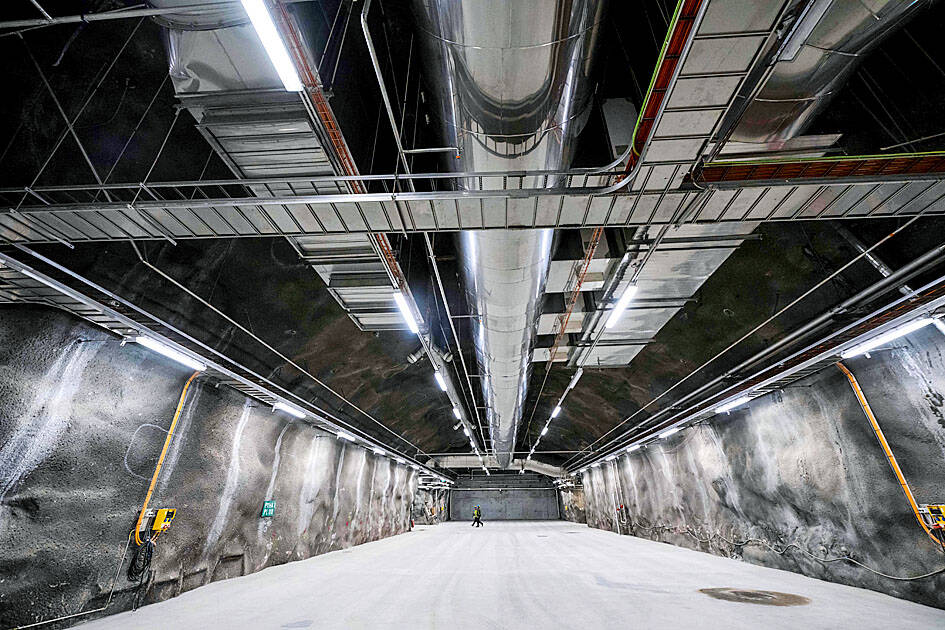
Photo: AFP
The Onkalo repository is designed to house a total of 6,500 tonnes of uranium, covering the spent fuel produced by Finland’s five nuclear reactors during their lifetime.
Low-carbon nuclear power has been hailed as a climate-friendly energy source as the world struggles to combat global warming.
However, environmentalists worry about their safety and warn that disposing radioactive waste carries huge risks.
About 400,000 tonnes of used fuel have been discharged from reactors worldwide so far, the World Nuclear Association estimates, most of which is stored in temporary storage facilities near power plants.
However, the long-term storage problem has cast a shadow on nuclear projects.
Onkalo’s operator, Posiva, has developed its solution together with the Swedish Nuclear Fuel and Waste Management Co (SKB).
The plan is to encapsulate the used uranium in thick copper shells and bury the up to 5m-long canisters in the bedrock, before sealing the tunnel with a massive, wedge-shaped and steel-reinforced concrete plug.
Construction began at Onkalo — Finnish for “hollow” —- in 2004, and final trials are to be conducted early next year.
“Once we have established that we are ready, we can then move on to the actual operational phase in the mid-2020s,” said geologist Johanna Hansen, Onkalo’s research and development coordinator.
FINAL RESTING PLACE
The immense amount of time it takes for radiation to decrease to safe levels poses significant challenges.
It can take about 250,000 years for the high-level toxic waste to reach the radiation levels of a naturally occurring uranium deposit.
Put in context, 250,000 years ago Europe was in the midst of an Ice Age and was home to Neanderthals and mammoths, while Homo sapiens had only recently emerged in Africa.
In other words, before the waste no longer poses a threat to the environment or people, the landscape of Olkiluoto island may have changed dramatically.
Posiva said the canisters are designed to withstand even major changes taking place on Earth.
However, some experts have cast doubt on the Finnish-Swedish disposal method.
“It is not a solution; it’s a reduction of risk,” said Jan Haverkamp, a nuclear energy expert at Greenpeace.
Haverkamp said Posiva is giving “no real attention” to the discourse around corrosion of the copper canister in Sweden.
For example, researchers at the Swedish Royal Institute of Technology (KTH) have questioned the plan’s safety by highlighting greater risks of copper corrosion than previously acknowledged, which could result in leakage.
“The case for not producing more waste is still standing as strong as it was standing 20 years ago,” he added.
Posiva and SKB have refuted KTH’s experimental studies, and the Finnish Radiation and Nuclear Safety Authority has concluded that the plans meet the requirements of nuclear and radiation safety.
Allison Macfarlane, professor at the University of British Columbia, said that while no plan is “100 percent safe,” Onkalo is “certainly the solution that’s received the most research.”
The alternative would be “leaving the waste where it is above ground without a plan indefinitely,” he added.
If the nuclear waste is left above ground and our society falls apart, “it will definitely get into the environment and affect humans,” she said.
She believes that in a reasonably selected location, the waste “will remain safe for thousands and tens of thousands of years.”
“I think it is the internationally agreed-upon solution to the problem of nuclear waste,” she said.
LEADING THE WAY
Locations for potential nuclear waste repositories have been selected in Sweden, France and Switzerland, with Canada close to making a decision.
“Now that we are leading the way, others are following and doing the same,” Hansen said.
However, many projects have faced resistance and locations have been difficult to agree on, such as France’s Cigeo project in the country’s northeast.
In April, Finland’s next-generation Olkiluoto 3 nuclear reactor, the largest in Europe, went into regular production.
A poll published the same month by the trade association Finnish Energy showed record-high support for nuclear energy in Finland, with 68 percent of Finns in favor.
“Sweden and Finland have shown us that the technical challenges can be surmounted,” Macfarlane said.
“Other challenges that need to be addressed are the political ones,” she said.
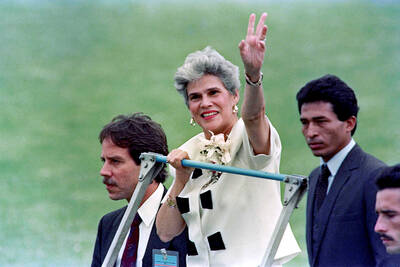
Former Nicaraguan president Violeta Chamorro, who brought peace to Nicaragua after years of war and was the first woman elected president in the Americas, died on Saturday at the age of 95, her family said. Chamorro, who ruled the poor Central American country from 1990 to 1997, “died in peace, surrounded by the affection and love of her children,” said a statement issued by her four children. As president, Chamorro ended a civil war that had raged for much of the 1980s as US-backed rebels known as the “Contras” fought the leftist Sandinista government. That conflict made Nicaragua one of
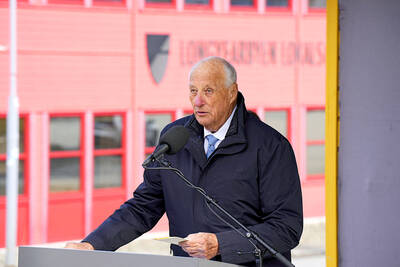
COMPETITION: The US and Russia make up about 90 percent of the world stockpile and are adding new versions, while China’s nuclear force is steadily rising, SIPRI said Most of the world’s nuclear-armed states continued to modernize their arsenals last year, setting the stage for a new nuclear arms race, the Stockholm International Peace Research Institute (SIPRI) said yesterday. Nuclear powers including the US and Russia — which account for about 90 percent of the world’s stockpile — had spent time last year “upgrading existing weapons and adding newer versions,” researchers said. Since the end of the Cold War, old warheads have generally been dismantled quicker than new ones have been deployed, resulting in a decrease in the overall number of warheads. However, SIPRI said that the trend was likely
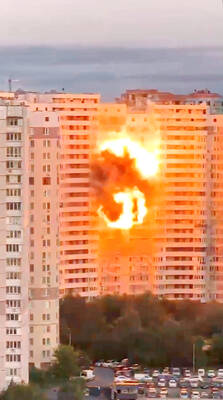
BOMBARDMENT: Moscow sent more than 440 drones and 32 missiles, Volodymyr Zelenskiy said, in ‘one of the most terrifying strikes’ on the capital in recent months A nighttime Russian missile and drone bombardment of Ukraine killed at least 15 people and injured 116 while they slept in their homes, local officials said yesterday, with the main barrage centering on the capital, Kyiv. Kyiv City Military Administration head Tymur Tkachenko said 14 people were killed and 99 were injured as explosions echoed across the city for hours during the night. The bombardment demolished a nine-story residential building, destroying dozens of apartments. Emergency workers were at the scene to rescue people from under the rubble. Russia flung more than 440 drones and 32 missiles at Ukraine, Ukrainian President Volodymyr Zelenskiy
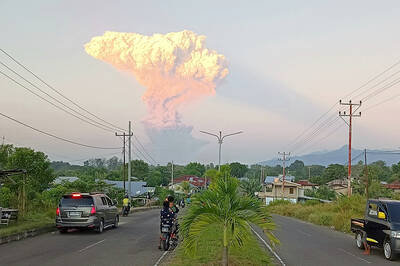
Indonesia’s Mount Lewotobi Laki-Laki yesterday erupted again with giant ash and smoke plumes after forcing evacuations of villages and flight cancelations, including to and from the resort island of Bali. Several eruptions sent ash up to 5km into the sky on Tuesday evening to yesterday afternoon. An eruption on Tuesday afternoon sent thick, gray clouds 10km into the sky that expanded into a mushroom-shaped ash cloud visible as much as 150km kilometers away. The eruption alert was raised on Tuesday to the highest level and the danger zone where people are recommended to leave was expanded to 8km from the crater. Officers also